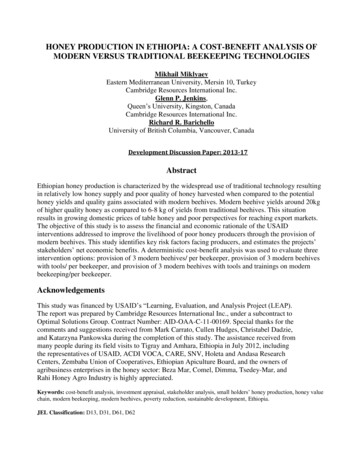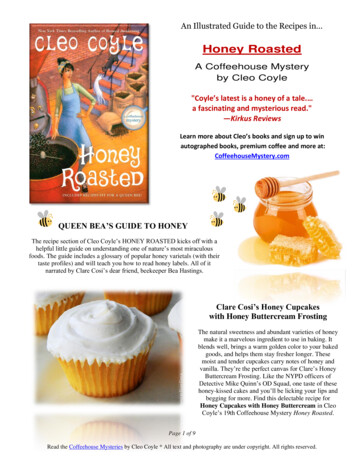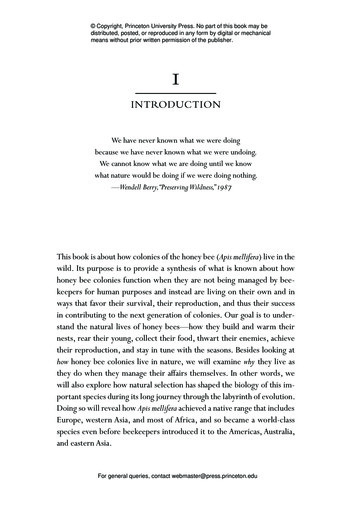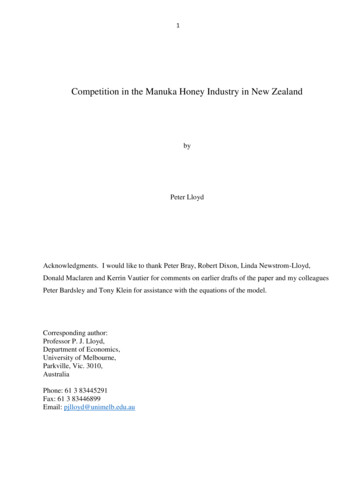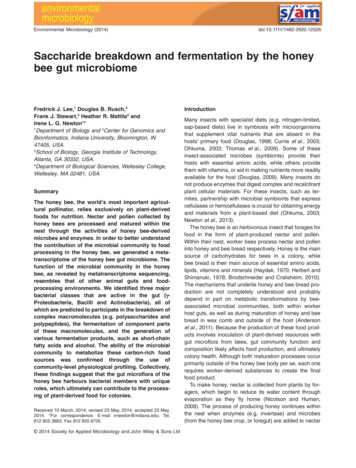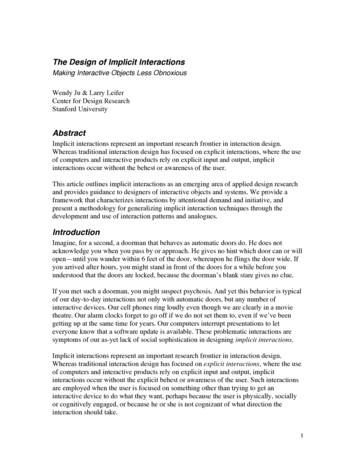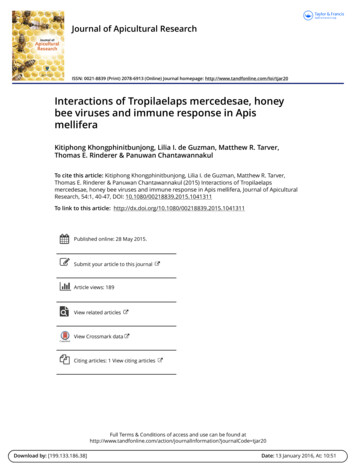
Transcription
Journal of Apicultural ResearchISSN: 0021-8839 (Print) 2078-6913 (Online) Journal homepage: http://www.tandfonline.com/loi/tjar20Interactions of Tropilaelaps mercedesae, honeybee viruses and immune response in ApismelliferaKitiphong Khongphinitbunjong, Lilia I. de Guzman, Matthew R. Tarver,Thomas E. Rinderer & Panuwan ChantawannakulTo cite this article: Kitiphong Khongphinitbunjong, Lilia I. de Guzman, Matthew R. Tarver,Thomas E. Rinderer & Panuwan Chantawannakul (2015) Interactions of Tropilaelapsmercedesae, honey bee viruses and immune response in Apis mellifera, Journal of ApiculturalResearch, 54:1, 40-47, DOI: 10.1080/00218839.2015.1041311To link to this article: lished online: 28 May 2015.Submit your article to this journalArticle views: 189View related articlesView Crossmark dataCiting articles: 1 View citing articlesFull Terms & Conditions of access and use can be found tion?journalCode tjar20Download by: [199.133.186.38]Date: 13 January 2016, At: 10:51
Journal of Apicultural Research, 2015Vol. 54, No. 1, 40–47, GINAL RESEARCH ARTICLEInteractions of Tropilaelaps mercedesae, honey bee viruses and immune response inApis melliferaKitiphong Khongphinitbunjonga, Lilia I. de Guzmanb, Matthew R. Tarverb, Thomas E. Rindererb andPanuwan Chantawannakula,c*aBee Protection Laboratory, Faculty of Science, Department of Biology, Chiang Mai University, Chiang Mai, Thailand; bHoney Bee Breeding,Genetics and Physiology Laboratory, USDA-ARS, Baton Rouge, LA, USA; cFaculty of Science, Materials Science Research Center, Chiang MaiUniversity, Chiang Mai, ThailandDownloaded by [] at 10:51 13 January 2016(Received 11 February 2013; accepted 15 May 2014)Tropilaelaps mites are the major health threat to Apis mellifera colonies in Asia because of their widespread occurrence,rapid population growth and potential ability to transfer bee viruses. Honey bee immune responses in the presence offeeding mites may occur in response to mite feeding, to the presence of viruses, or to both. In this study, the mRNAexpression levels were measured for three antimicrobial peptide encoding genes (abaecin, apidaecin and hymenoptaecin)and a phagocytosis receptor gene (eater) in worker brood infested with different numbers of actively feeding T. mercedesae.Also, all samples were measured for the amount of acute bee paralysis virus (ABPV), black queen cell virus (BQCV),deformed wing virus (DWV), Kashmir bee virus (KBV) and sacbrood virus (SBV). Using an artificial mite inoculation protocol, the analysis showed that apidaecin was significantly down-regulated when tan-bodied pupae were infested with 1–2mites and when capping of the cells of newly sealed larvae were opened and closed without mite inoculation (o/c) ascompared to the control group (undisturbed brood, no mite inoculation). Reduced transcription levels of the eater genewere also recorded in the o/c group. However, an up-regulation of apidaecin and eater genes was observed in highlyinfested pupae when compared to o/c group. This occurrence is perhaps due to an adaptive response of the bees to highermite infestations by up-regulating their immune expression. No significant expression differences were detected forabaecin and hymenoptaecin and the viruses ABPV, KBV and SBV were not detected. However, 86.7% of the pupae wereinfected with DWV, 83.3% were infected with BQCV and 73% were infected by both of these viruses. In addition, theTropilaelaps-inoculated pupae showed higher levels and incidence of DWV compared to uninfested pupae. The presence ofthese two honey bee viruses was not related to the number of T. mercedesae infesting the pupae. Also, the presence ofvariable levels of DWV and low levels of BQCV did not provoke any expression differences for any of the targeted genes.Overall, this research indicates that feeding by Tropilaelaps mites produces an immune response, that the level of virusesdid not produce a correlated immune response by the four genes tested and that Tropilaelaps may be a potential vector ofDWV but not to a high degree. The data indicated that the major impact of Tropilaelaps infestation is caused by the miteitself.Interacciones de Tropilaelaps mercedesae, virus de las abejas de la miel, y la respuesta inmune en ApismelliferaLoa ácaros Tropilaelaps son la principal amenaza para la salud de las colonias de Apis mellifera en Asia debido a supresencia generalizada, el crecimiento acelerado de la población y la capacidad potencial de transferir virus de las abejas. La respuesta inmune de la abeja de la miel en presencia de ácaros alimentándose puede ocurrir como respuesta ala alimentación de los ácaros de alimentación, a la presencia de virus, o a ambos. En este estudio, se midieron los niveles de expresión de ARNm de tres genes antimicrobianos codificantes de péptidos (abaecin, apidaecin, hymenoptaecin)y un gen del receptor de la fagocitosis (eater) en crı́a de obreras infestada con diferentes números de T. mercedesae enfase de alimentación activa. Además, se midieron en todas las muestras la cantidad de virus de la parálisis aguda de lasabejas (ABPV), virus de la celda real negra (BQCV), virus de las alas deformadas (DWV), el virus Cachemira de abejas(KBV) y el virus de la crı́a ensacada (SBV). Mediante el uso de un protocolo de inoculación artificial del ácaro, el análisis mostró que apidaecin fue significativamente sub-regulada cuando la pupa en fase oscura se infestó con 1-2 ácaros ycuando la limitación de las células de las larvas recién sellada se abrió y cuando el sellado de las celdas de las larvasoperculadas recientemente se abrieron y cerraron sin inoculación del ácaro (a / c) en comparación con el grupocontrol (crı́a sin perturbaciones, sin la inoculación de ácaros). También se registró una reducción de los niveles detranscripción del gen eater en el grupo a / c. Sin embargo, se observó una sobre regulación de los genes apidaecin yeater en pupas altamente infestadas, en comparación con el grupo a / c. Este hecho es quizás debido a una respuestaadaptativa de las abejas a infestaciones de ácaros más altas mediante la sobre regulación de su expresión inmune. Nose detectaron diferencias significativas de expresión para abaecin y hymenoptaecin y no se detectaron los virus ABPV,KBV y SBV. Sin embargo, el 86,7% de las pupas estaban infectadas con DWV, el 83,3% con BQCV y el 73% con ambosvirus. Además, las pupas inoculadas con Tropilaelaps mostraron niveles más altos e incidencia de DWV en comparacióncon pupas no infestadas. La presencia de estos dos virus de abejas de miel no estuvo relacionada con el número de T.mercedesae infestando las pupas. Además, la presencia de niveles variables de DWV y bajos niveles de BQCV noprovocó ninguna expresión diferencial para cualquiera de los genes especı́ficos. En general, esta investigación indica que*Corresponding author. Email: panuwan@gmail.comThe work of Lilia I de Guzman and Thomas E Rinderer was authored as part of their official duties as an Employee of the United States Government and is therefore awork of the United States Government. In accordance with 17 USC. 105, no copyright protection is available for such works under US Law. Lilia I de Guzma andThomas E Rinderer hereby waive their right to assert copyright, but not their right to be named as co-authors in the article.Kitiphong Khongphinitbunjong, Matthew R. Tarver and Panuwan Chantawannakul hereby waive their right to assert copyright, but not their right to be named as co-authorsin the article
Journal of Apicultural Research41la alimentación por los ácaros Tropilaelaps produce una respuesta inmune, que el nivel de virus no produjo unarespuesta inmune correlacionada con los cuatro genes probados y que Tropilaelaps puede ser un vector potencial deDWV pero no a un nivel elevado. Los datos indicaron que el mayor impacto de la infestación por ácaros Tropilaelapses causado por el propio ácaro.Downloaded by [] at 10:51 13 January 2016Keywords: Tropilaelaps mercedesae; Apis mellifera; immune response; antimicrobial peptides; honey bee virusIntroductionWorldwide, parasites and pathogens present seriousthreats to the health of the European honey bee (Apismellifera). In Asia, A. mellifera is commonly infested withtwo different genera of parasitic mites (Varroa spp. andTropilaelaps spp.) (Anderson & Morgan, 2007; Anderson& Roberts, 2013; Anderson & Trueman, 2000). Althoughthese mites have similar life cycles (Kapil & Aggarwal,1987, 1989), the populations of Tropilaelaps spp. aregenerally higher than populations of varroa in A. melliferacolonies (Anderson & Morgan, 2007; De Jong, De Jong,& Goncalves 1982; Oldroyd & Wongsiri, 2006). Hence,in Asia, Tropilaelaps mites inflict more serious damage toA. mellifera colonies than varroa (Burgett, Akratanakul, &Morse, 1983; Burgett, Rossignol, & Kitprasert, 1990;Koeniger & Musaffar, 1988; Laigo & Morse, 1968; Otis &Kralj, 2001).The puncture wounds caused by the feedingactivities of V. destructor provide entry for bee diseases(Chen & Siede, 2007). Several bee viruses have beenreported to be associated with varroa mite infestation(De Miranda et al., 2013; Tentcheva et al., 2004).Deformed wing virus (DWV) is the most common virusassociated with varroa infestation causing wingdeformities and decreased body size of infected adultbees (Chen & Siede, 2007). These symptoms are part ofa phenomenon termed parasitic mite syndrome(Shimanuki, Calderone, & Knox, 1994). Like varroa,Tropilaelaps feeds and reproduces within capped broodcells causing abnormalities and sometimes death tobees (Burgett et al., 1983). Recently, the presence ofT. mercedesae in A. mellifera colonies was reported to beassociated with the infection of DWV in China(Forsgren, De Miranda, Isaksson, Wei, & Fries, 2009).Further, virus replication has also been documented inDWV-positive T. mercedesae together with their infestedhost bees (Dainat, Ken, Berthoud, & Neumann, 2009).Therefore, T. mercedesae may be considered to be abiological vector of DWV.Honey bees mount both humoral and cellular immuneresponses at wound sites caused by V. destructor(Casteels-Josson, Zhang, Capaci, Casteels, & Tempst,1994; Kanbar & Engels, 2003). Yang and Cox-Foster(2005) reported that varroa caused immunosuppressionin parasitised A. mellifera although other studies have suggested that immuno-suppression is inconsistent (e.g.,Gregory Evans, Rinderer, & De Guzman, 2005). AlthoughDWV-positive varroa mites have been collected fromThai A. mellifera colonies (Chantawannakul, Ward,Boonham, & Brown, 2006), no studies have been done todetermine the presence of DWV in T. mercedesae inThailand. Additionally, the immune response of A.mellifera towards Tropilaelaps parasitism and to the different honey bee viruses this mite may vector remainsunknown. Therefore, this study was conducted to compare the levels of A. mellifera honey bee immune-peptidetranscripts between unparasitised honey bees and thoseparasitised with different numbers of T. mercedesae in aThai population of A. mellifera. The presence of differenthoney bee viruses and their potential effects on theexpression of immune genes was also investigated.Materials and methodsExperimental designThe test colony (A. mellifera) used in this study wasapparently mite-free with no observable bacterial orfungal diseases. Age-controlled brood was obtained bycaging the queen (24 h) with a push-in wire screen (8mesh) on an empty comb. The test section of broodconsisted of 20 rows with 20 brood cells per row.Inoculum female Tropilaelaps were collected from thenewly sealed worker brood of a highly infested colony.Adult female mites were individually introduced intonewly sealed larvae in the test section of brood using atransfer technique established for varroa (Garrido &Rosenkranz, 2003; Kirrane et al., 2011). Briefly, thistechnique involved using a minute pin to create a smallopening at the edge of the cell capping of a newly sealedlarvae, through which individual Tropilaelaps were transferred using the tip of an insect brush. The tip of theinsect brush was moistened with a small amount ofhoney to facilitate mite inoculation by slowing themovement of the mite being introduced. The cappingwas pressed back quickly using the insect brush toreseal the opening. Cohort brood cells were randomlyassigned to one of four groups: (a) brood inoculatedwith one mite; (b) brood inoculated with two mites; (c)brood with capping opened and closed without miteinoculation; and (d) undisturbed brood cells (control).At the time of mite inoculation, the positions of theinoculated brood were mapped on a transparency sheet.Prior to returning the frame into the host colony, thetest brood section was covered with a screen wirepush-in cage (8 mesh) to prevent worker bees fromremoving the inoculated brood. Seven days after miteinoculation, brood cells were examined for the presenceor absence of mites. All tan-bodied pupae and the mitesinfesting them were collected separately and wereplaced in a 80 C freezer until RNA extraction.Since some introduced foundress mites reproducedinside the brood cells, infested pupae were re-grouped
42Downloaded by [] at 10:51 13 January 2016Table 1.K. Khongphinitbunjong et al.Sequences of the tested immune genes, TaqMan primers and probes for Real-Time Quantitative RT-PCR.PrimerTarget5 to 3 sequenceReferenceAm actin-FAm -TReference TGAGTTGTGAAATTTTGTGAGCATTGTSimone et al. elaps319-TAntimicrobial peptideReceptorAntimicrobial peptideAntimicrobial peptideKashmir bee virus (KBV)Acute bee paralysis virus (ABPV)Deformed wing virus (DWV)Black queen cell virus (BQCV)Sacbrood virus (SBV)ITS1–5.8S-ITS2 rRNA geneEvans (2006)Simone et al. (2009)Simone et al. (2009)Evans (2006)Chantawannakul et al. (2006)Chantawannakul et al. (2006)Chantawannakul et al. (2006)Chantawannakul et al. (2006)Chantawannakul et al. (2006)Chantawannakul et al. (2006)Chantawannakul et al. (2006)Chantawannakul et al. (2006)Notes: F, forward primer; R, reverse primer; T, probe. Probes consist of oligonucleotides with a 5 reporter dye (FAM, 6-carboxy-Xuorescein) anda 3 quencher (TAMRA, tetra-methylcarboxyrhodamine.for PCR analysis based on the number of active feedingmites (foundress, young female and male adults andnymphs) present in each pupal cell. Eggs were not considered. The test groups were as follows: (a) pupaeinfested with 1–2 mites; (b) pupae infested with 3–4mites; (c) pupae infested 5–6 mites; (d) pupae infested7–8 mites; (e) pupae where the wax cappings of thecells were opened and closed without mite inoculation(o/c); and (f) pupae from undisturbed cells (control).Since cell capping were deliberately opened to introducemites, the o/c group served as a control check todetermine whether the manipulation of cell cappingalone also triggered a response. Ten pupae were sampled for each group. None of the test pupae wereinfested with varroa mites.RNA extraction and cDNA synthesisTotal RNA was extracted from individual pupae andtheir corresponding Tropilaelaps foundress using TRIzolreagent (Invitrogen, Carlsbad, CA, USA) according tothe manufacturer’s protocol. DNA was removed usingDNAse I by incubation at 37 C for 1 h followed by 10min at 75 C. First-strand cDNA was generated fromapproximately 2 g total RNA using 50 U Superscript III(Invitrogen, Carlsbad, CA), 2.5 nmol DNTP mix and 2.5nmol oligo (dT)20. The synthesis was carried out at50 C for 50 min followed by 5 min at 85 C and 20 minat 37 C after added RNAse H (Invitrogen).Quantitative PCR amplification for immune genesThe cDNA products were amplified with an IQ5 RealTime PCR thermal cycler (Bio-Rad) using EXPRESSSYBR GreenER qPCR SuperMix Universal (Invitrogen).Gene-specific primers are listed in Table 1. The thermalprogramme for all reactions was 95 for 2 min followedby 40 cycles of 95 C for 30 s, 60 C for 30 s and 72 Cfor 1 min 20 s. Fluorescence signal was measured inevery cycle during the annealing step to quantify product amount. At the end of the PCR reaction, a meltcurve dissociation analysis was conducted to confirmproduct size.The results were expressed as the threshold cycle(Ct) value, which illustrated the number of cycles neededto generate a fluorescent signal greater than a predefined threshold. Relative gene expression of the numberof infested mites was determined by normalising the Ct
Journal of Apicultural Researchvalue of the reference gene (-actin) to the target gene(ΔCt) for each sample. The expression was calculated as(Ct control Ct target) (Evans et al., 2006; Evans et al.,2013).Quantitative PCR amplification for viruses presentin bee and mite samplesAll individual pupae and foundress mites were amplifiedfor virus detection and quantification. The cDNAproducts were amplified using FastStart TaqMan ProbeMaster (Roche) on an IQ5 Real-Time PCR thermalcycler (Bio-Rad) with each specific primer and TaqManprobe set as listed in Table 1. Plates were cycled usingestablished system conditions (48 C for 30 min, 95 Cfor 10 min and 40 cycles of 60 C for 1 min plus 95 Cfor 15 s) as described by Chantawannakul et al. (2006).Downloaded by [] at 10:51 13 January 2016Statistical analysisTranscription levels were normalised using SPSS version17.0 for Windows (SPSS Inc., 2008). Data on targetgene transcription levels for pupae exposed to differentnumbers of mites were analysed using one-wayANOVA. Where differences were found, the meanswere compared using a Tukey-HSD with a 95% confidence. Pearson’s correlation coefficient was used todetermine relationships between the levels of DWV inpupae and in the harvested mites (SAS Institute, 2008).ResultsExpression of apidaecin was significantly (F 3.10, df 5,P .016) down-regulated in pupae that had their cell capping manipulated (o/c) and in pupae infested with 1–2mites when compared to the control treatment (undisturbed brood cells) (Figure 1). The immunity gene eaterwas also significantly (F 4.349, df 5, P .002) downregulated in the o/c group as compared to the controlgroup (Figure 2). However, the transcription levels ofboth apidaecin and eater genes numerically increased inhighly infested groups as compared to the o/c group.There were no statistical differences among the transcript levels for any of the groups for the immune genesabaecin (F 1.109, df 5, P .366) and hymenoptaecin(F 1.485, df 5, P .210) even though numericalincreases of transcription levels were observed.We do not understand why the o/c manipulationresulted in a down-regulation. However, if we acceptthis down-regulation as a baseline observation for allmite treatment groups and reanalyse the data using o/cas the control, the results differ somewhat. ANOVAresults indicate that pupae with 7–8 mite producedmore apidaecin than o/c pupae (F 2.843, df 4,P .035) but not the other pupae with lower numbersof infesting mites (Figure 1). Production of eater wasalso higher in the 3–4 and 7–8 mite groups than in o/cgroup (F 3.545, df 4, P .013) (Figure 2). However,43this procedure did not alter the results for abaecin(F 1.338, df 4, P .271) or hymenoptaecin (F 1.679,df 4, P .171). Regression analyses of transcriptionlevels with numbers of active mites identified significantrelationships for apidaecin (r .428, P .002), eater(r .299, P .035) and hymenoptaecin (r .305,P .031). No correlation was detected between thetranscription level and number of active mites forabaecin (r .213, P .138).Quantitative viral analysis of bee pupae and the adultmites infesting them showed that all samples were negative for three honey bee viruses: acute bee paralysisvirus , Kashmir bee virus and sacbrood virus. Additionally, mites were negative for black queen cell virus andonly had DWV. However, 86.7% (52 of 60) pupae samples were found positive with variable levels of DWV(Ct 30.08 6.27) and 83.3% (50 of 60 pupae) werefound positive with low levels of BQCV (Ct 35.78 1.46). About 73% of the test pupae were concurrentlyinfected with DWV and BQCV. The incidence and levelsof BQCV did not differ among all test groups. We alsofound that Tropilaelaps infested pupae (Ct 26.76 .78)have significantly higher level of DWV than uninfestedpupae (Ct 36.05 1.00) (F 53.43, df 1, P .001).Importantly, no correlation between DWV levels inpupae and expression levels of the four target geneswas detected [abaecin (r .018, P .89); apidaecin(r .021, P .87); hymenoptaecin (r .122, P .35);and eater (r .042, P .74)].When foundress Tropilaelaps retrieved from theinfested brood cells were analysed, 42% were infectedwith DWV (17 of 40). Of those that were infected, significantly lower levels (t 4.34, P .0001) of DWV(Ct 36.48 3.04) were detected as compared to theircorresponding bees (Ct 28.00 7.46). The individuallevels of DWV in all the mites retrieved from pupal cellsdid not vary among the test groups (F 1.91, df 3,P .146) and did not influence the levels of DWV intheir pupal hosts (r .115, P .478).When comparing the proportion of bee pupae andtheir corresponding T. mercedesae with or withoutDWV, the majority of samples fell into two maingroups: (1) DWV-positive bees infested with DWVpositive mites and (2) DWV-positive bees infested withDWV-negative mites. The remaining samples fell intotwo additional yet minor groups: (3) DWV-negativebees infested with DWV-positive mites and (4) DWVnegative bees infested with DWV-negative mites(Table 2). Based on the frequency of infection of DWVin bees and mites, the association of infections in Table 2indicates that bees with infected mites are more ofteninfected than bees without infected mites (χ2 6.7,df 3, P .009).DiscussionOf the four genes tested, only apidaecin and eater displayed differential expression levels among treatments
44K. Khongphinitbunjong et al.Table 2. Percentages of bee pupae and their corresponding T. mercedesae with or without DWV. Chi-square analyses test independence of association of infected bees and infected mites.Control groupBee and mite ––2040––100010––20(χ2 45.6, P .0001)0030(χ2 75.3, P .0001)Relative transcription of mRNADWV-positive beeDWV-negative beeDWV-positive bee and miteDWV-positive bee, DWV-negativemiteDWV-negative bee, DWV-positivemiteDWV-negative bee and 1-23-45-67-8Number of Active Mite FeedersFigure 1. Expression levels (mean SE) for pupae exposedto different numbers of T. mercedesae for the apidaecin gene.Notes: Bars with different letters are significantly different(ANOVA, P .05). Letters above the bars inside () show thedifferences in expression levels when reanalysed without thecontrol. Control – undisturbed cells without mite inoculation,o/c – small opening made along the edge of cell capping andthen pressed closed without mite inoculation.Relative transcription of mRNADownloaded by [] at 10:51 13 January 2016Mite ol3-45-67-8Number of Active Mite FeedersFigure 2. Expression levels (mean SE) for pupae exposedto different numbers of T. mercedesae for the eater gene.Notes: Bars with different letters are significantly different(ANOVA, P .05). Letters above the bars inside () show thedifferences in expression levels when reanalysed without thecontrol. Control – undisturbed cells without mite inoculation,o/c – small opening made along the edge of cell capping andthen pressed closed without mite inoculation.although these genes and hymenoptaecin all showedhigher transcript levels with increasing mite numbers.The expression of the immunity-related gene apidaecinshowed an initial down-regulation with the o/c treatment and with lower numbers of feeding mites but anincrease in expression as mite numbers increased(Figure 1). It is also previously reported that highernumbers of varroa mite feeding could induce moreimmune responses (Gregory et al., 2005). However, wedid not observe the suppression of immune response inA. mellifera by Tropilaelaps in our experiments, similar tothose observed in varroa (Gregory et al., 2005; Yang &Cox-Foster, 2005).A reduced amount of transcription for the eatergene was also recorded in the o/c group compared tothe control group (Figure 2). Eater also was down-regulated with low mite numbers and transcription levelsnumerically increased as mite numbers increased.Eater regulates a major receptor and plays an importantrole in recognition and phagocytosis in Drosophila(Ertürk-Hasdemir & Silverman, 2005; Kocks et al.,2005). The infested pupae might enlist both humoral(apidaecin) and cellular (eater) responses to protectthemselves from microbial infection through woundsderived from mite feeding.It is interesting to note that both apidaecin and eatershowed a significant down-regulation in response to themanipulation of cell cappings (Figures 1 and 2). Currently, we have no explanation for this down-regulationin response to the creation of a small opening in the cellcapping, but we assume that this down-regulation issimilar for all pupae in cells that were opened.No significant differences were noted in thetranscription levels for the gene abaecin or the gene hymenoptaecin although hymenoptaecin did show a positive(r .31) regression with numbers of infesting mites.These weak or non-responses might be due to thesegenes having specific and different functions as immunerelated genes (Evans et al., 2006). Both abaecin andhymenoptaecin have been shown to increase expressionin response to microbially challenged honey bees(Casteels, Ampe, Jacobs, & Tempst, 1993; Casteels
Downloaded by [] at 10:51 13 January 2016Journal of Apicultural Researchet al., 1990) and Bombus terrestris (Erler, Popp, &Lattorff, 2011). Zhang, Liu, Zhang, and Han (2010)observed similar low transcription levels of the immunerelated genes phenol oxidase and defensin in both varroainfested and uninfested A. mellifera. Alternately, theseweak or non-responses may be a result of the immunesuppression ability of the mite which may act morestrongly for these genes.In addition to the expression of the four immune-related genes, we also examined the viral levels for eachpupal bee sample and corresponding mites. Researchwith varroa has shown that these parasites enhance theprevalence and distribution of viruses (Chen & Seide,2007; Martin et al., 2012). Although we found higherDWV levels in infested than uninfested pupae, viralreplication in either pupae or mites was not determinedin this study. However, the results clearly showed thatthe mite could carry DWV genetic material, and DWVreplication has been reported to occur in Tropilaelaps(Dainat et al., 2009). This suggests that the mite is apotential vector of DWV. Nevertheless, there weremore cases of pupae with DWV, and the correspondingmites having no DWV than there were of the miteshaving DWV and the bee pupae not having the virus(Table 2). These results are similar to past research thatalso showed the presence of DWV in the honey beehosts and the absence of the virus in their matchingT. mercedesae (Forsgren et al., 2009). These observations indicate virus transmission to pupae is not dependent upon mites. Although bee viruses can be detectedin a single varroa mite (Chantawannakul et al. 2006), noBQCV was detected in any of the Tropilaelaps infestingthe bees that were infected with BQCV. This suggeststhat Tropilaelaps mites do not act as a BQCV vector andthat the BQCV may not be able to infect the mites.The impact that the mite-virus complex has on theoverall health and survivability of honey bee colonies isstill not fully understood. Bee viruses are routinelyfound in apparently healthy colonies (Martin et al.,2012). In our study, the variety of viruses is less thanfound in studies involving A. mellifera in varroa in othercountries (Sanpa & Chantawannakul, 2009). Yet, theTropilaelaps mite in and of itself is clearly able to destroyhoney bee colonies. These contrasts suggest that viralinfections vectored by the varroa mite may be moreserious than viral infections vectored by Tropilaelaps.Certainly, no viruses other than DWV could be foundin Tropilaelaps. This observation is supported by previous research in Northern Thailand where it wasobserved that in colonies where both varroa and Tropilaelaps were present, multiple types of viral infectionscould be found in comparison with colonies that wereonly infested with Tropilaelaps that had fewer types ofviral infections (Sanpa & Chantawannakul, 2009).This research focused on the expression of fourwell-known insect immunity genes. For a more complete picture of the immune response of A. mellifera toT. mercedesae infestation, additional genes should be45tested. For example, Nazzi et al. (2012) used RNA-seqwith a gene list of 166 genes from Evans et al. (2006) tocompare the transcriptional profile of bees collectedfrom colonies with high and low varroa infestati
Mediante el uso de un protocolo de inoculacio n artificial del a caro, el ana li-sis mostro que apidaecin fue significativamente sub-regulada cuando la pupa en fase oscura se infesto con 1-2 a caros y cuando la limitacio n de las ce lulas de las larvas recie n sellada se abrio y cuando el sellado de las celdas de las larvas
